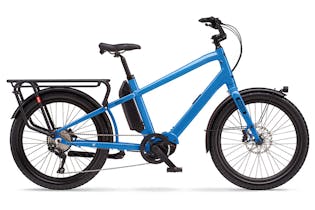Electric bikes
Find the best e-bike for your lifestyle. We’ve tested 43 current and 20 discontinued models to see which e-bikes are best in different situations.
Find the best range of electric bikes in New Zealand with our e-bikes reviews and buying guide. We've tested over 40 bikes to help you choose the right ride, whether it's for daily use, road commutes or hitting the trails.
Buy the best electric bike for your lifestyle

Buying an e-bike is a big purchase, with prices from around $2,000 to over $10,000. Use our expert reviews to buy the best electric bike for your lifestyle.
Our assessment covers:
- Daily (urban) use
- Road use
- Cargo use
- Trail use
- Mountain biking use
- Quality.
Best electric bikes in New Zealand 2025
Our expert recommendations help you find the best electric bike for your lifestyle, looking at how they perform for daily, cargo, road, trail and mountain biking use. We also consider build quality, features and price.
-

Best value e-bike
-

Best cheap e-bikes
-

Best all-round e-bike
-

Best road e-bike

Get access to Consumer & see all reviews
✔ Personal support through our Consumer Rights Advice Line
✔ Premium articles and in-depth buying advice
✔ Add a Consumer magazine for even more exclusive content
What you need to know when buying an e-bike
Buying an e-bike is an exciting step towards sustainable and efficient transportation, so choosing the right e-bike is crucial. Check out the top questions and features to look for in our electric bikes buying guide.
Appearance and design: We outline all the features an e-bike might have, so you know what you might need for your ride.
Journey style: Just like regular, unpowered bikes, e-bikes come in various shapes and sizes, each better suited to different types of riding and riders. See which types of bikes are most suitable for your trips.
Battery and runtime: Find out how long an e-bike battery lasts and how long it takes to recharge.
Get the most out of your electric bike
Learn how to maximise your electric bike experience with expert advice on commuting, selecting the best bike locks, and choosing the brand with the best motors.
E-bike commuting guide
It might have been some time since you last rode a bike, so before you head out, check out our guide to the quirks of riding an e-bike.
How to choose the best bike lock
How do you make your bike seem too much bother to a thief? Choosing the right lock is the best place to start.
Electric bike motors tested
Five motor brands dominated our electric bikes test. Here’s a summary of what they offer, and what we think of them.

First Look: Rubbee X e-bike conversion kit
Keen to give e-biking a go, but don’t want to break the bank for a whole new bike? A simple conversion kit could be the answer.
People's Choice

Our People's Choice awards are granted to brands that consistently rate above average for customer satisfaction and meet out other performance criteria. Become a member and see which brands have earned a People’s Choice award.
Which bike brands are most reliable?

We asked thousands of Consumer members about their experience with products they've used to find out which brands are most reliable and satisfying to own. The results are available to members and Digital Pass holders.
Other electric vehicles
Looking for a different kind of eco-friendly ride? We’ve looked at e-mopeds, electric motorbikes, and cars. See if these could be an alternative option for cost-efficient travel.
Best retailer to buy sports and outdoor equipment from

Many things can ruin a shopping experience – a pushy salesperson, the product you wanted not being in stock or having to fork out more than you intended. We asked consumers to tell us the best and worst. Become a member to see the best stores to purchase sports and outdoor equipment from.
How we test electric bikes

We test e-bikes for five uses: Mountain, Trail, Road, Daily, and Cargo. We check how well they handle cargo, how easy they are to mount, and how good their suspension, stability, and brakes are. We also look at how the e-bike's motor responds to pedalling, its assistance levels, ability to climb hills, and battery range.
We've tested 63 electric bikes.
Find the right one for you.
Benno
.jpg&w=315&q=75)
Benno
.jpg&w=315&q=75)
Benno



